For years, friends have raved that Easter Island is the most spiritual place they have ever visited. This speck of land in the eastern Pacific, known to locals as Rapa Nui, had been on my wish list for years. Since childhood I had read about the Moai, enormous statues that the indigenous people carved and raised on platforms near the shoreline. Explorers and visitors alike have always been intrigued by the mystery of Easter Island. Where did the first inhabitants come from? When did they arrive? How did they get there? How and why were the Moai of Easter Island created? And perhaps the most intriguing question of all, how did they move statues that weighed tons without the use of cranes or sophisticated technology?
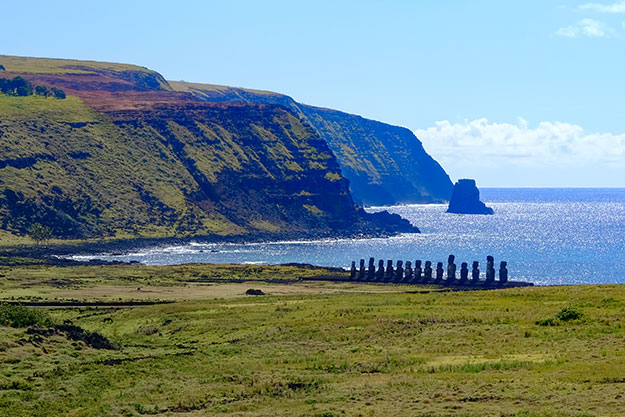
Debate continues to rage with regard to many of these questions. Though local legend says the first people arrived on Easter Island sometime between the 8th and 9th centuries, recent archeological evidence points to an arrival during the 13th century. Despite conflicting theories that posit South America as the source of the first settlers, recent DNA testing has confirmed what locals have always insisted: the original inhabitants were from the Marquesas Islands in Polynesia. They likely arrived in dugout canoes, having navigating more than 2,000 miles through uncharted seas until they reached this most remote island in the world. But while some of the many mysteries surrounding Easter Island have been solved, others persist.
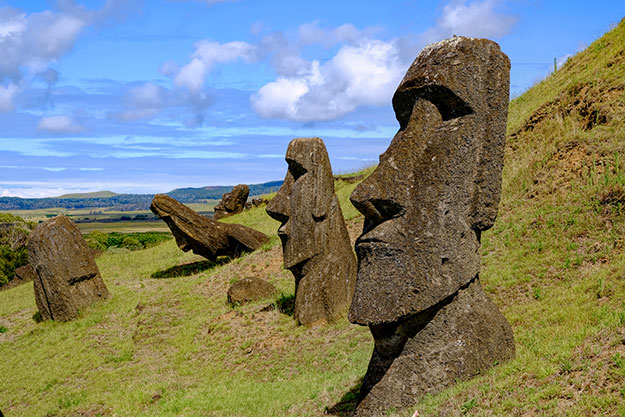
For more than a century, a myth has persisted that indigenous peoples disappeared as a result of dwindling resources. Explorers and researchers espoused Euro-centric theories that trees were felled en masse for cooking, building dugout canoes, and to move the giant Moai. With no trees to hold the soil, the island was reduced from a lush, tropical paradise to a barren, erosion-plagued rock that could no longer support crops. As food became scarce, the story went, the remaining residents gradually died off from starvation or wars that erupted between the tribes. I’ve always thought this was a ridiculous theory. After all, if I was living on an island where all the trees were disappearing, wouldn’t I use one of the remaining ones to build a canoe and head out in search of new horizons? Today, experts are beginning to understand that this long held narrative is pure fiction.
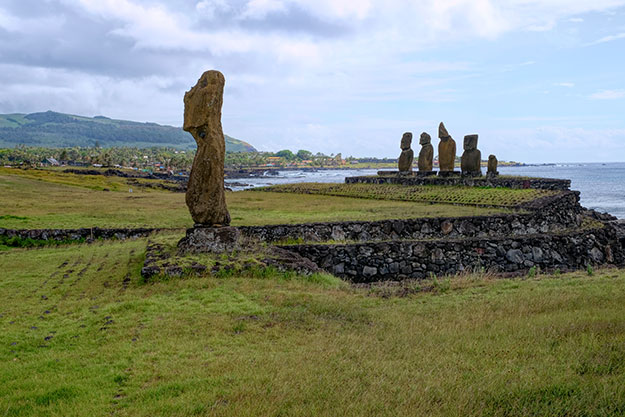
Within a couple of centuries of arrival, the Rapa Nui people had developed a complex culture that was organized into ten tribes. The chiefs of each tribe were said to have “mana,” magical powers that imbued them with great knowledge. When a chief died, it was imperative that his mana not be lost. His body was interred beneath the lower level of a two-tired platform of volcanic rock known as an ahu. Moai were then raised upon the upper tier, facing inland. Once upright, eye hollows were carved in the Moai and lined with coral for the whites of the eyes and obsidian for the corneas. The eyes of the Moai were believed to transmit the mana of the ancestors buried beneath them to their descendants. Thus, ancestor worship became the focus of life on the island and the construction of Moai the most important function in society.
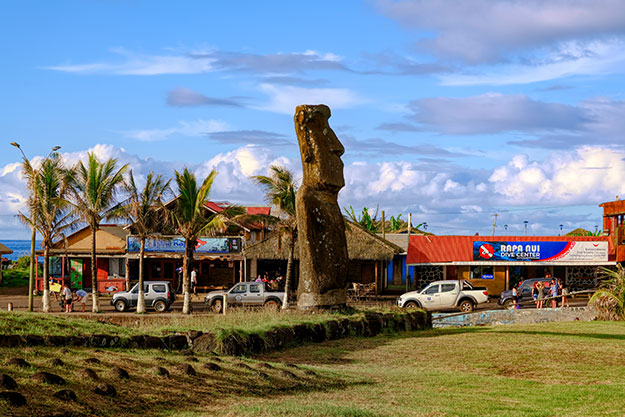
Such was the situation when Rapa Nui was “discovered” by Dutch Admiral Roggeveen on Easter Day in 1722. He named the island for the day he first sighted it and the name stuck. The official ship’s log describes the Moai, which were at that point still standing:
“What form of worship of these people comprised we were not able to gather any full knowledge of, owing to the shortness of our stay among them; we noticed only that they kindle fire in front of certain remarkably tall stone figures they set up; and, thereafter squatting on their heels with heads bowed down, they bring the palms of their hands together and alternately raise and lower them. At first, these stone figures caused us to be filled with wonder, for we could not understand how it was possible that people who are destitute of heavy or thick timber, and also of stout cordage, out of which to construct gear, had been able to erect them; nevertheless some of these statues were a good 30 feet in height and broad in proportion.”
The log later reconfirms the lack of mature trees:
“we found (the island)…exceedingly fruitful, producing bananas, potatoes, sugar-cane of remarkable thickness, and many other kinds of the fruits of the earth; although destitute of large trees and domestic animals, except poultry.”
Roggeveen’s log is proof that the first Europeans to visit Rapa Nui found a thriving civilization, on an island nearly devoid of trees. Unfortunately, the commander’s official log did not come to light until 1836 and by that time, wildly embellished stories told by members of the crew had taken root in the human psyche.
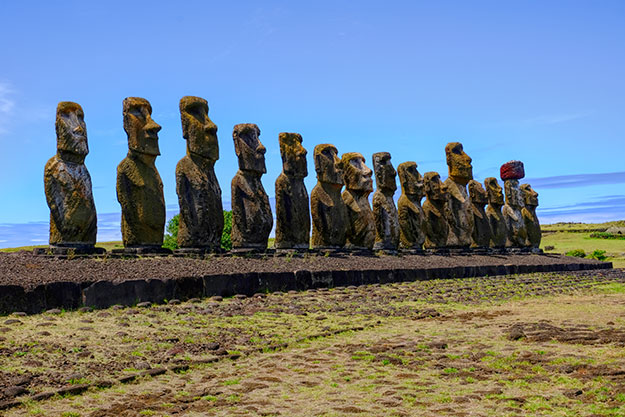
The next recorded visit by Europeans was in 1770 when the Viceroy of Peru (then a holding of Spain) sent two Spanish Royal Navy vessels to annex “a portion of land in the eastern Pacific Ocean believed to lie about six hundred leagues west from the coast of Chile.” During that visit, Captain Don Felipe Gonzalez found the natives to be docile and accommodating, with abundant food and water and no indication of societal decline. He claimed the island in the name of the Spanish Monarch Don Carlos III, and sailed back to Peru. So if dwindling resources and wars were not responsible for the decline of Easter Island, what was?
By the time Captain James Cook arrived in 1774, things had taken a turn for the worse. The natives, who during previous encounters had cheerfully shared their food, had little to offer the British sailors. Many researchers speculate that the Rapa Nui were struck with diseases carried by the Spaniards on the earlier voyage. It was not uncommon for sailors to suffer from a variety of diseases during long voyages. Scurvy was always present due to the lack of fresh fruit. Cook himself suffered a bout of “bilious cholic” three weeks prior to arriving at Easter Island. As there was no fresh meat aboard, the ship’s doctor offered up his favorite dog as a remedy. The dog meat stew did the trick; Cook recovered enough to set foot on Rapa Nui, though he was so weak that he did not leave the beach.
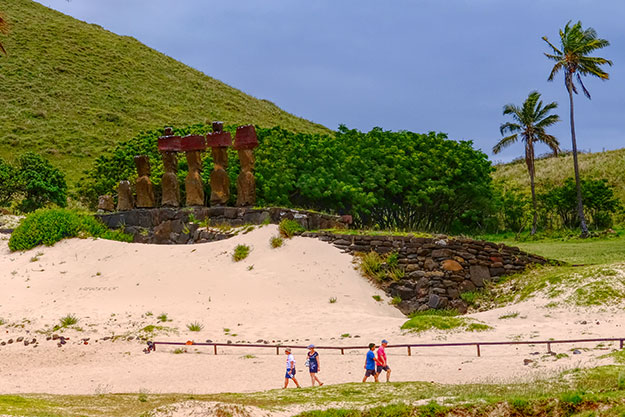
If the Spanish crew infected Rapa Nui with Smallpox or similar diseases for which they had no natural immunity, the sickness would have run rampant through the population. Indeed, after Chile annexed the island in 1888, disease broke out following every delivery of supplies from the continent.
As for the condition of the Moai of Easter Island, many had been toppled during the four years between the Spanish visit and Cook’s arrival. From written accounts we know that most of the Moai were in place until late in the 18th century, but by the early 19th century, not a single one remained standing. Is it possible that declining human resources forced stoppage of work at the quarry? And if the statues were no longer being carved, did competing tribes resort to destroying the Moai of other clans in order to protect their access to the mana?
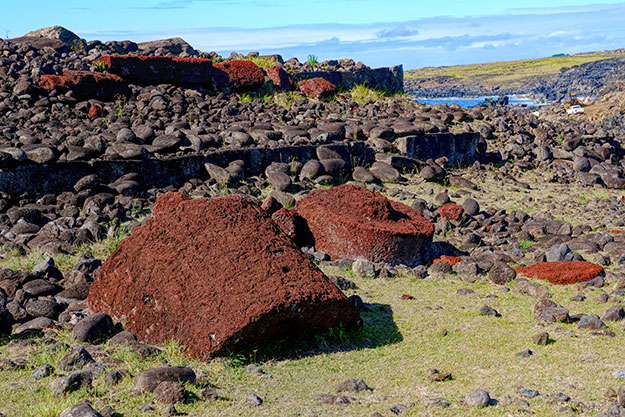
Some might question whether these immense carved figures could possibly have been the impetus for war. I can only speculate, but my visit to Rano Raraku, the quarry where all Moai were carved in situ, affected me deeply. In a 1921 article in National Geographic Magazine titled, The Mystery of Easter Island, researcher and author Mrs. Scoresby Routledge described the Moai quarry at Rano Raraku:
“A conspicuous image first strikes the beholder; then, as he gazes, he finds that the walls on either hand are themselves wrought into figures, and that, resting in the niche above him, is another giant; he looks down and realizes with a start that his foot is resting on a mighty face.”
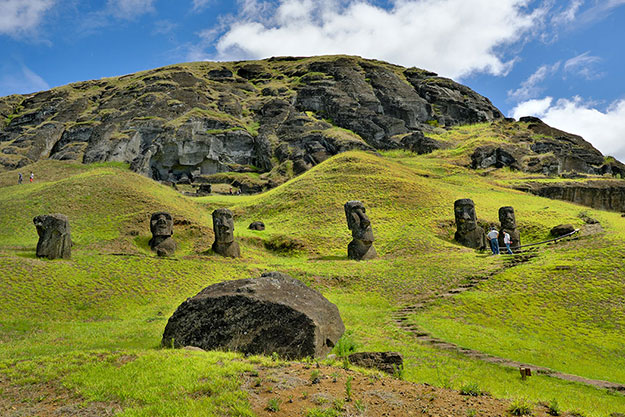
This description might well have been written on the day I visited Rano Raraku quarry. Supine figures lay in various stages of completion. On the flanks of the hill a nearly complete Moai waited to be detached from the rock. Just above it, further back in the rock face, the nose and lips of another horizontal figure could be seen. On my right, a third was emerging from the rock diagonally. My eyes scanned the ledge above these three figurines and I picked out another three or four Moai laddered up the face of the extinct volcano. Incredibly, 397 Moai were abandoned in various stages of completion.
There is still a great mystery regarding how the Moai were moved from the quarry to their platforms. Scientists seem particularly attached to a theory that they were transported across miles of rocky landscape by rolling them on felled tree trunks. They tested that theory some years ago and declared it a success. However, while they did succeed in moving a huge concrete Moai replica some distance on thick tree trunks, they needed a crane to lift the statue onto the logs.
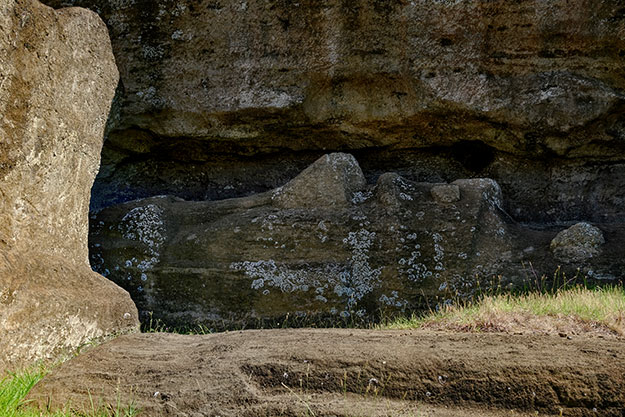
According to descendants of the Rapa Nui, the Moai were moved with mana – the statues were said to “walk” to their ultimate destination. Scientists also tested a method that could have been used to make the Moai “walk.” They attached ropes to the head and shoulders of a figure and took positions on either side of it. By pulling alternately on the ropes, they were able to rock it back and forth. With each tug, it inched forward, seeming to walk down a path. When it arrived at the ahu, a Moai would likely have been raised up by gradually inserting rocks and sand beneath it until it stood upright.
Further up the quarry trail I rounded a corner and came face to face with a monolithic black head protruding from the grassy field. I stopped in my tracks as if held by a sci-fi tractor beam. Waves of energy streamed off the Moai. A thin layer of purple color hugged the surface of the rock. Further out was a wider band of intense clear blue, followed by a thin white band. The energy field pulsated, growing wider and then shrinking. For many years I have been able to see energetic auras around people and things, but I have never witnessed anything as powerful as the energy that surrounded that Moai.
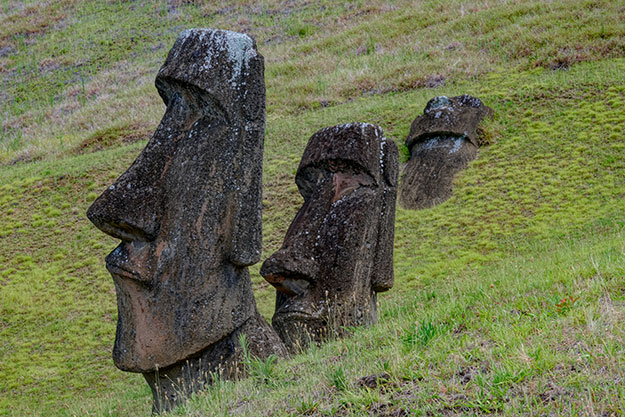
Sadly, neither mana nor the Moai were able to save Rapa Nui from near total devastation. During the early 19th century, slave raiders carried off most of the remaining adult population to Peru. In the process, they brought another Smallpox epidemic to the island. By 1877, only 111 residents remained. Catholic missionaries also left their mark. In their zeal to convert the population to Christianity, they forbade the Rapa Nui to speak their local language, get tattoos, or perform their native songs and dances. With no access to their culture, the islanders lost the will to live and even more died off. Fortunately, a Franciscan Capuchin priest named Father Sebastian Englert arrived on the island in 1935. Recognizing the harm that was being done, he immediately reversed the prohibitions and began learning the local language. When their culture was restored, the Rapa Nui began to thrive once again.
With a decent understanding of Easter Island culture and history, I set out on my second day to see Ahu Ko Te Riku, the only Moai that has ever been discovered with intact eyes. Luckily, it stands on the coastline, only a ten-minute walk from where I was staying. Once again, I felt the immense power of the Moai. Colors swirled around and flowed out from it in all directions. A thin line of energy that outlined the body alternated between fire-engine red and bright gold. Beyond that was a mottled field of green and yellow, framed by an outer layer of white tinged with pale blue. “Whoa!” I said out loud. I sat in front of it and meditated. The colors grew stronger and throbbed. I asked if it had a message for me. Suddenly, all the swirling energy turned a deep bright red. “Oh my, you are angry,” I said.
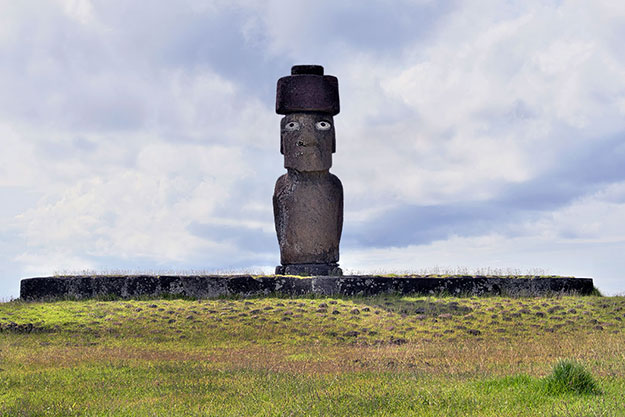
The Moai are very upset about the way we are destroying the planet. Ahu Ko Te Riku explained that there is much less time than we think to save the environment. Destruction is coming swiftly, so much so that even at my age I will see the effects unless something is done now. I finally looked up and saw black clouds roiling in the sky, headed directly for me. I collected my things and double-timed it back to my guest house, arriving just as fat drops began to fall.
I no longer accept the theory that the indigenous population disappeared due to willful destruction of their environment. Rather, this was a civilization that not only endured, but thrived, in a land where life was anything but easy. By all indications, they must have been unparalleled stewards of their environment – at least until Europeans arrived. It’s hardly surprising that the Moai are furious over how poorly we are caring for our precious Earth.
It’s been six weeks since I returned from Easter Island and the message I received from the Moai still reverberates in my head every time I turn on the water or take a taxi rather than walking. I have a feeling that the island is not yet done with me, that I am destined to return at some future time. If so, I will do things a little differently. A five-day itinerary for seeing everything that Easter Island has to offer is more than adequate, but next time I will rent a car so that I can spend as much time as I choose at each of the major Moai sites and discover more of the lesser-known sites. I’m certain the Moai have more wisdom to share with me.

we enjoyed your very nice articles.
Wow! Your post made me consider this very beautiful spiritual place. I want to experience it firsthand.
And yes, climate change is real. I often think whether I should really bear children or not.
I don’t know what to say, I absolutely fell in love with your writing style. I learned so many things about Easter Island. Thank you
What a nice thing to say Sazjan. Thank you so much.
I has been looking through a number of your articles about this website and I believe this web page is really informative! Keep upon posting.
Fantabulous photography & information!
Thank you very much, Barbara, for taking me with you to wonderful places. Best, Georgia
Thanks so much Georgia. Happy you enjoyed my story.
Barbara, this is an amazing story. Such a wonderful experience for you to be able to tune into the energy of the Maoi. Seems like that even today history is repeating itself when it comes to our treatment of other cultures and our environment. So sad. We need to wake up now and not let this happen.
Thanks so much Elizabeth. I feel so lucky to have been able to visit Easter Island, or Rapa Nui, as the locals cal it, and to have had such an astounding experience with the Moai. I hope we start listening to these wake-up calls, and I hope we do so before it’s too late.
Wikipedia explains more clearly what we collectively might claim to know about Easter Island. I recommend reading there.
I enjoy Barbara Weibel’s blog. But this post is too ephemeral. For instance this phrase, whilst very well put, is no more than a comment of a privileged traveler who, like a seagull comes, sees and goes away again (I hesitate to supply the actual allegory about what seagulls do when they fly in). “Destruction is coming swiftly, so much so that even at my age I will see the effects unless something is done now.”. Destruction is nothing new on Easter Island. The island used to be forested, ask who have had anything to do with the removal of trees?
I wanted to read from Barbara far more about the effect of tourists, commercialisation and developments on Easter Island. I wanted to hear what are the actual actions and plans to keep the island as pristine as possible. Had I heard more about this from Barbara then it would have added to her reputation as one of the more responsible travel bloggers inspiring and influencing us. It would be good to see travel bloggers adding more content in their reports as on-the-spot location-status reporters whilst continuing to describe just how attractive a place can be described or photographed/instagrammed.
Good lord Philip: Wikipedia??? I read three books, numerous scientific research papers, three ancient ships logs, and spent an entire day in the museum library on Easter Island before writing this article. It is extensively researched, which is more than I can say for Wikipedia. Reading Wikipedia will get you the normal blather about how the Rapa Nui people cut down all the trees and destroyed their environment, which ultimately led to their disappearance. This legend has been around for almost two hundred years, and it is now being debunked. Easter Island had virtually no trees when the first European explorers arrived in the early 1700’s, and again when a second ship visited in the mid 1700’s, yet according to the ship’s logs for both visits the tribes were flourishing. It’s clear that the Rapa Nui did not go into decline until after the second ship visited. By the time Captain Cook arrived a few years later, the locals were decimated, most likely by diseases brought by European explorers. Other scientists and researchers are coming around to the same conclusion. I wasn’t writing about the political situation, or the current environmental or social situation. It was a historical and scientific based research piece, interwoven with my personal experience with the Moai.
Thank you so much for such an interesting article and pictures of the Maoi.
I have always wanted to know more of the history of Easter Island ant the giant heads.
How wonderful that you are able to travel and experience all the wonders of our planet.
Bless you for sharing,
Thank you so much for saying that Lynne. Bless you for taking the time to leave a comment that made my day!
One time while meditating I had an intense vision of Easter Island, which I still think about. This was my vision..
Blue sky, no clouds, green grass, rolling hills and a statue about 100 meters away.
Big “Gonging” noise, resonating and continuously humming. A feeling of ancient very powerful energy. In the center a very large, heavey, wooden carved ring (circular, disc shaped object), upright, floating about 3 meters off the ground. The wooded ring was floating in a similar to how you would imagine a monk meditating and levitating above / off the ground. Except this was a wooden object.
The feeling I had was quite profound and felt very ancient. The vision came from nowhere, I was not trying or thinking, I was simply meditating to clear my thoughts and to relax. It felt like I was in the crossfire of some electrical signal that was showing me this magical floating disc on easter island. … who knows ..
This all sounds a bit mad, but if you’ve ever had any sort of vision, or have any knowledge of ancient religions, a large wooded ring. I’d be interested to hear more. I am curious.
Hi Yasmin: I don’t think it sounds mad at all. I’m also fascinated by ancient religions and spirituality. I meditate often, but I can’t say I’ve ever had a vision of a wooden floating ring. However, I think meditation is a very personal thing and messages come to different people in different ways. Mine are rarely visual. They are thoughts, the source of which I know can’t possibly have been from me. I wonder how you felt when viewing the ring. That may be a clue. Thanks so much or sharing your vision with me and my readers. Fascinating!
Fascinating. It must have been very powerful to see the intense auras and take the time to wait to hear the message. It deeply grieves those who love our incredibly beautiful rich earth to see it being so wounded. I wonder if seeing auras around people has helped you in your travels – sensing who to trust and who to avoid. Thanks for sharing this and the message.
Hi Wendy. Interesting that you should ask that question. When I was younger, I was a very poor judge of character. The year I turned 40 I began to see the auras around people very vividly. Frankly, it can be very distracting when all this energy comes flowing at me all the time, so I learned to sort of “turn it off” unless I want to see it. But I do believe that I still “feel” the energy of people. The moment I meet anyone, I immediately just sense if they are people I want to be associated with…or not. Maybe that’s just maturity, but it never lets me down, so I think there’s something much more energetic going on.
A very interesting commentary. I am glad you have shared it. We certainly are seeing the effects of climate change and I have 6 grandchildren who I worry about.
Hi Irene: Unfortunately, I also do a lot of worrying these days. I hope we’re not beyond the point of no return.
Enjoyed reading your comments and seeing your photos.
Hi, Barbara:
I was very happily planning a long-dreamed of trip to Japan until the Coronavirus scare began unfolding in the news. What are your thoughts regarding the risks? The news have reported the virus in a neighboring state and in Illinois and California. Are people canceling trips to Japan? Should I avoid traveling there? But then it’s spreading worldwide. I’d appreciate your insights
Thanks
Charlie J
Hi Charlie: I’m afraid I can’t give you any advice. I’m not a medical professional, and even if I were, I don’t think I’d want to offer a definitive opinion on whether or not you should travel. However, I can tell you what I’m doing. First of all, I live in Thailand, where 40 cases have been confirmed. Of those 40, 22 have recovered. There have been no deaths so far. In fact, I’m following the data every day from Johns Hopkins, and it does look like the number of reported cases each day are declining, while the number of recovered individuals are increasing. This, of course, could reverse as it continues to spread to other countries. It also looks like the death rate from Coronavius is about 2%. Just this morning, the CDC (Centers of Disease Control in the U.S.) confirmed that many people who have the virus have mild symptoms or even show no symptoms. Although there are exceptions, the majority of those who have died from it are elderly or people who have compromised immune systems or underlying complications/conditions.
In about a month I am scheduled to travel for another 4-6 weeks (at least a month in Spain), and I fully intend to go. My biggest worry at this point is the policies that governments are putting in place regarding travel restrictions. Just a few days ago, Bahrain said people from Thailand could not enter the country. No reason, no legitimate reasoning. I guess maybe they think too many Chinese tourists come to Thailand. Thailand, on the other hand has been much more reasonable that some countries; they haven’t even restricted travel by Chinese. But health professionals pretty much agree that Coronavirus is expected get worse before it gets better, so there’s always a chance that Thailand could decide that no one who has been to say, Italy, within the last two weeks can enter Thailand. I am taking the chance that I might not be able to go home, because I’m a legal resident, but not a citizen of Thailand. That worries me for sure. But I’m not particularly worried about Coronavirus. I will continue to travel, though not to places that have significant outbreaks. Hope that helps.
Thanks so much Mark! Glad you found my article interesting.
The story of Moai and Napa Rui is very interesting, the genesis of the statues has always fascinated a lot of researchers and with such detailed evidence coming into light, this gets more interesting as you get to know so much about them.
Thanks Stephanie. I have to admit that my views, and thus the premise of my article, evolved as I researched more and dug deeper. I hope now that scientists and journalists will disavow the incorrect theory that the Rapa Nui people destroyed their environment to such a degree that they all perished.